Harness Concepts: Rules, Rule Sets, Enforcements and Evaluations to optimise cloud costs
Rules
Rules help you set up Asset Governance for your cloud provider. A Rule is essentially a small file with a set of logic that you can run on your cloud infrastructure. For example, there might be a scenario in which you want to migrate all gp2 EBS volumes to gp3. In such a case, we write and run a rule which does this for us.
Ideally, rules include policy, resource, filters, and actions.
-
A policy is defined in YAML format and consists of filters and actions that are applied to a specific type of cloud resource.
-
A resource is the type of cloud resource or service on which the rule will be run with the actions and filters, such as ec2, s3, elb, etc.
-
A filter, as the name suggests, is a criteria used to narrow down the results based on the attributes. These attributes can include anything such as tags, metadata, or any other resource property provided by you. When the filter is applied, only those resources that match the criteria specified in the filter are given as a result.
-
Actions are operations performed on the filtered resources. Actions include things like migrating gp2 volumes to gp3, deleting snapshots with no volumes, or sending an email notification.

So essentially, a Rule is a file that includes logic defined by a policy that performs certain actions on the resource based on the filters provided by the user. Rules can include multiple policies, and policies include resource, filters and actions.
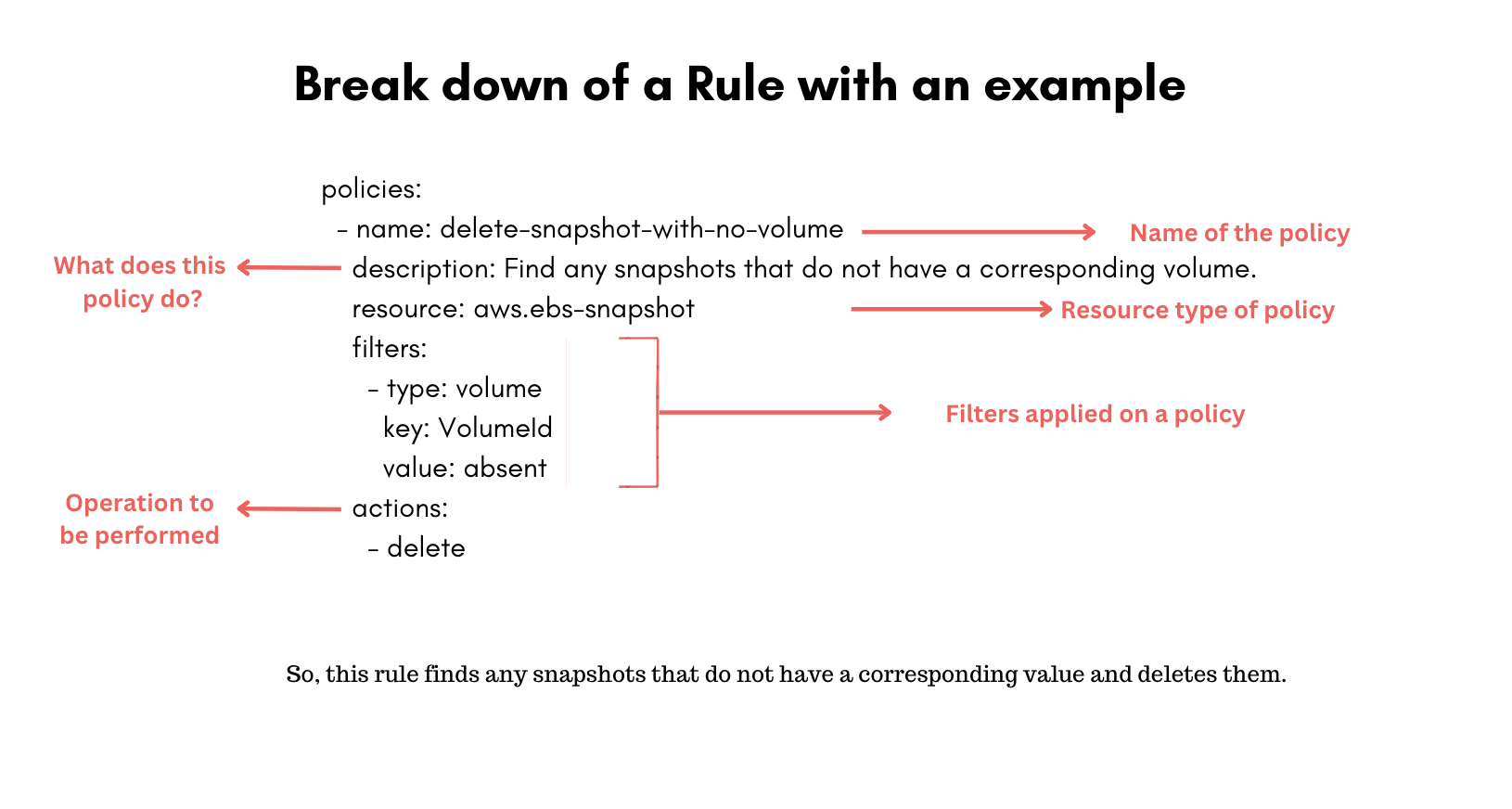
Create a new Rule
- In Harness, go to Cloud Costs.
- Select Asset Governance.
- Select Rules.
- Select + New Rule.
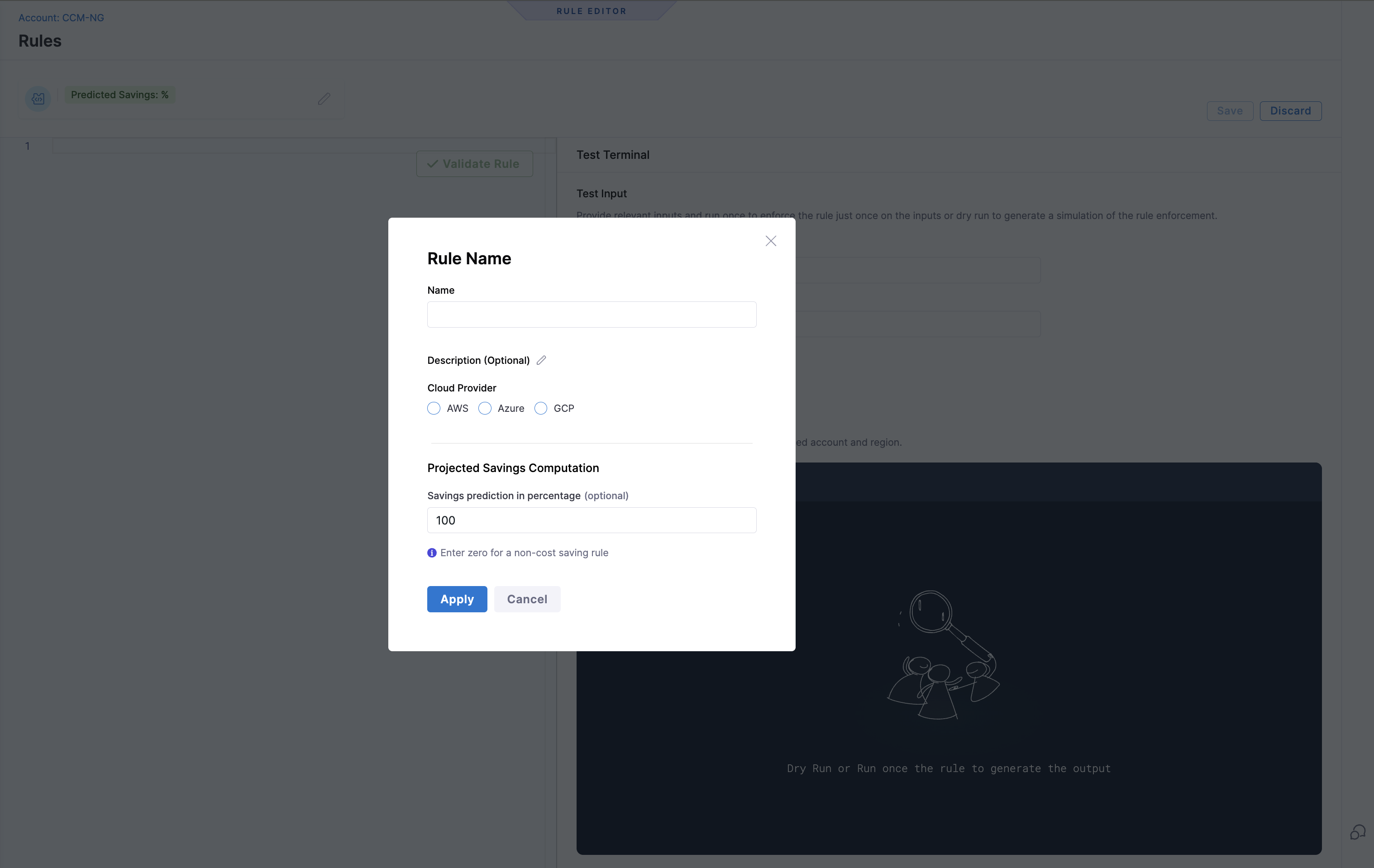
- Enter a name for the rule.
- Select the cloud provider. Also, enter Savings prediction in percentage (optional). This custom percentage will be honored during savings computation.
- Optionally, enter a description of the rule.
- Select Apply.
- Enter the YAML policy in the rule editor.
- Select Save. If the policy is invalid, an error message is displayed.
- Select the Account and the Region from the dropdown list in the Test Terminal.
- Select Dry Run to view the instances or services that will be acted upon when you enforce the rule.
- After evaluating the output, select Run Once to execute the rule.
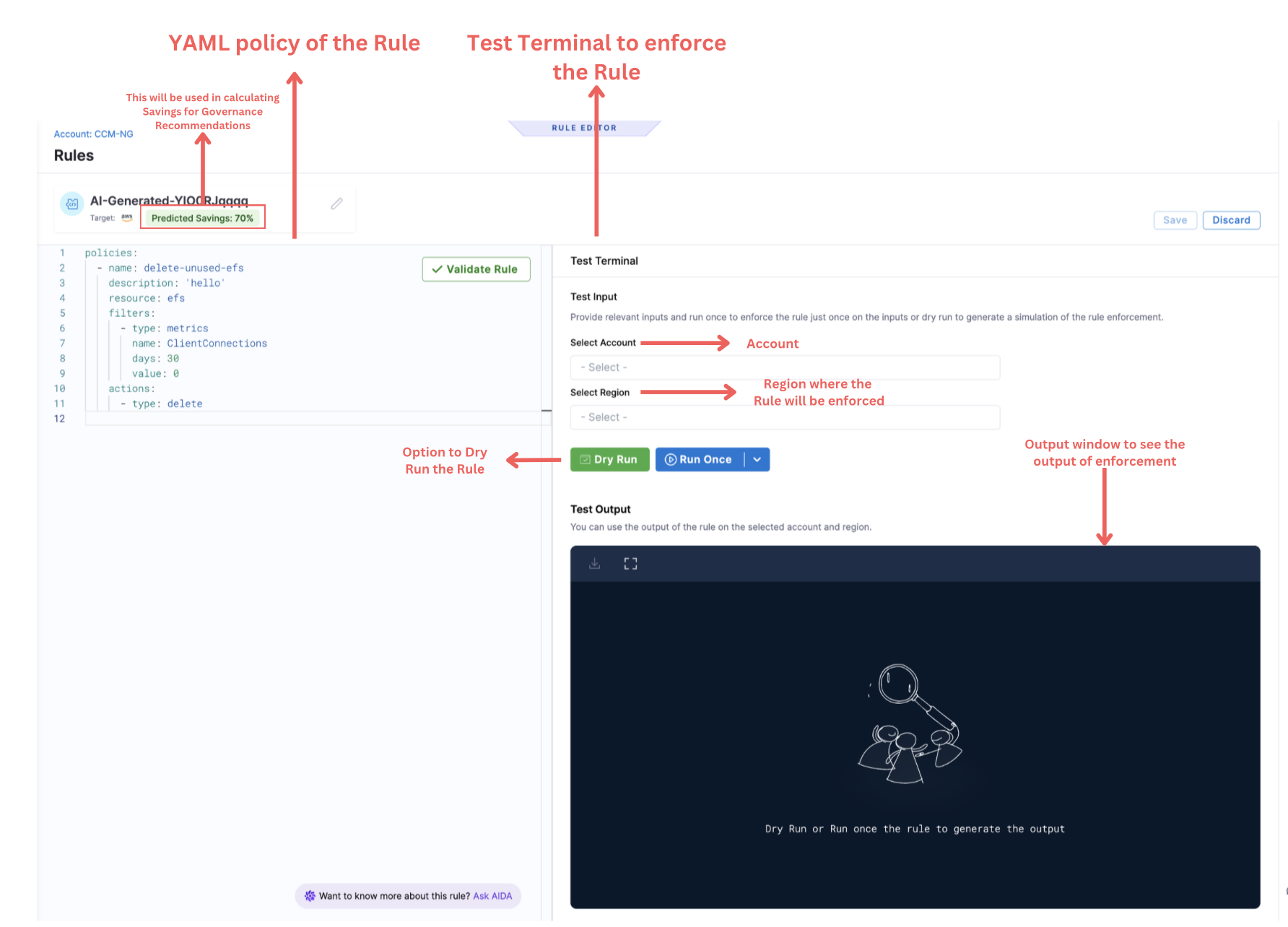
Harness provides some out-of-the-box policies for aws.ebs-snapshot, ebs, rds, etc. that can be enforced. These policies cannot be edited but can be cloned.
Update a Rule
You can view the Rules on the Asset Governance Rules page. You can click on Edit button from the vertical ellipsis menu (⋮) to edit a Rule or simply click on the Rule to open Rule editor and then make changes.
Delete a Rule
To delete a Rule Set, click on Delete from the vertical ellipsis menu (⋮).
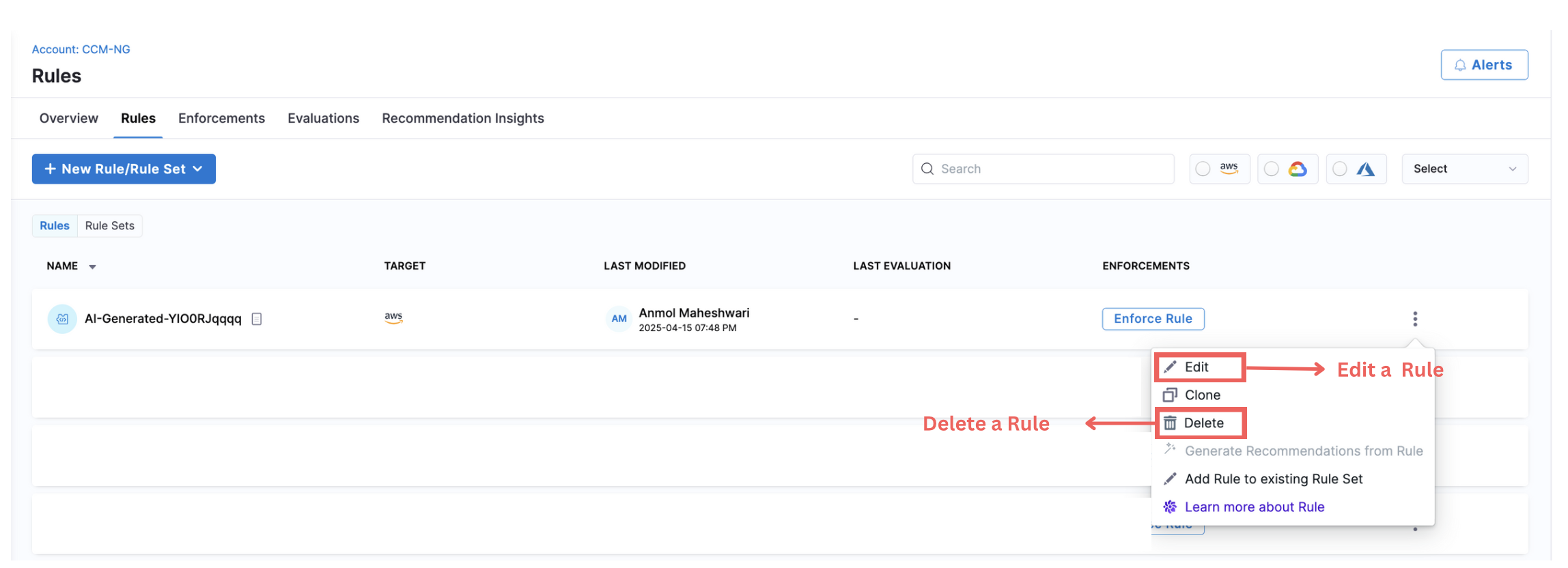
We now have Terraform support for managing Governance Rules. Please see here for more details.
Rule Sets
As mentioned previously, a Rule can have multiple policies. However, when there are multiple rules with multiple policies, it can become hard to manage them all together. This is where Rule Sets can be used. Rule sets serve as logical bindings on top of individual rules that help you organize and manage rules. By organizing rules into sets, organizations improve accessibility and simplify maintenance, as enforcements can be made against the entire rule set rather than individual rules.
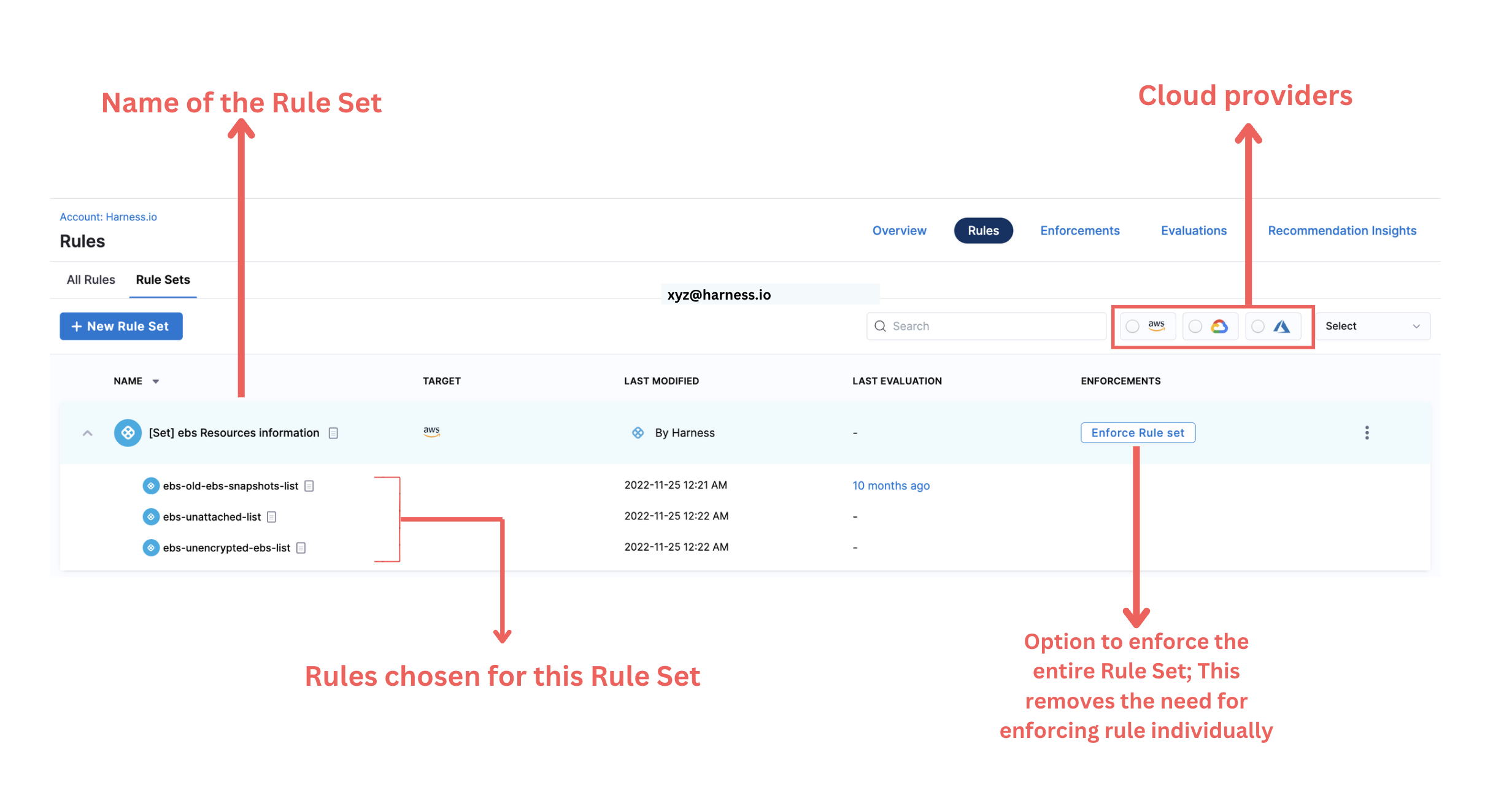
Create a new Rule Set
To create a Rule Set, perform the following steps:
- In Harness, go to Cloud Costs.
- Select Asset Governance.
- Select Rules.
- Select the Rule Sets tab.
- Select + New Rule Set.
- Enter a name for the rule set.
- Optionally, enter a description of the rule set.
- Select the cloud provider.
- Select the rules that you want to add to the rule set.
- Select Create Rule Set. The rule set is created successfully.
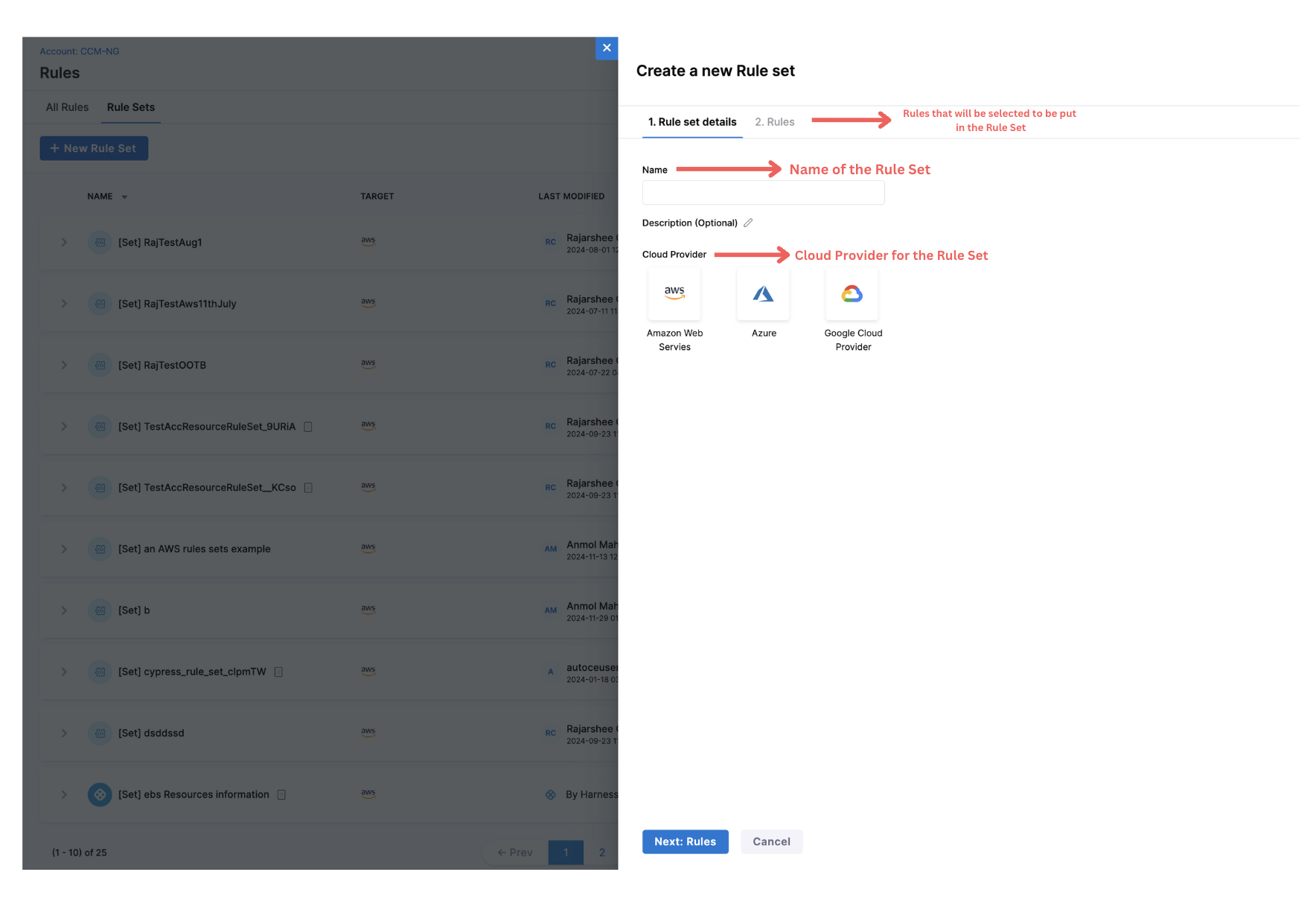
- You can view the rule set on the Asset Governance Rules page. Expand the rule set to view the individual rules in the rule set.
- Select Enforce Rule Set in the Enforcements column to enforce this rule set.
Update a Rule Set
You can view the Rule Set on the Asset Governance Rules page. Expand the rule set to view the individual rules in the rule set. You can click on Edit button from the vertical ellipsis menu (⋮) to edit the rule set.
Delete a Rule Set
To delete a Rule Set, click on Delete from the vertical ellipsis menu (⋮).

We now have Terraform support for managing Governance RuleSets. Please see here for more details.
Enforcements
Each enforcement can now have up to 10,000 evaluations. The cap is calculated as Rules × Accounts × Regions and replaces the earlier individual limits on rules, rule sets, accounts, or regions.
Enforcements enable you to enforce a certain set of Rules or Rule Sets (also known as governance guardrails) against a specific set of targets (accounts, projects, or subscriptions) to run periodically. Sometimes, we need rules to run periodically, such as every day, week, or month. However, running these rules manually every day or week at a specified time creates extra overhead and is a slow process prone to manual errors. To solve this, Enforcements allow users to set up a timely schedule and choose the day, time, and frequency for their rules or rule sets.
For example, a user can create an Enforcement to schedule the deletion of all unattached disks. This Enforcement will run on the days specified by the user, at the specified time, and with the specified frequency (hourly, daily, monthly). For instance, you could set it to run daily at 2:00 AM to ensure that unused RDS database is deleted. Alternatively, you might choose to run it hourly during peak usage times, or monthly for less critical cleanup tasks.
While setting up a new Enforcement, you can select the following:
-
Cloud provider: Currently we support AWS, Azure and GCP.
-
Rules/ Rule Sets: You can select the Rules or Rule Sets that your Enforcement will consist of.
-
Target Accounts and Regions: The target accounts and regions that you will be running the Enforcements on.
-
Frequency: The frequency for running the Enforcement. Currently, it can be set for hourly, daily or weekly.
-
Time: After setting the frequency, you can choose the time at which it runs.
-
Dry Run Mode: You can choose to run your Enforcement in Dry Run mode which will generate a simulation of the rule enforcement instead of performing actions.
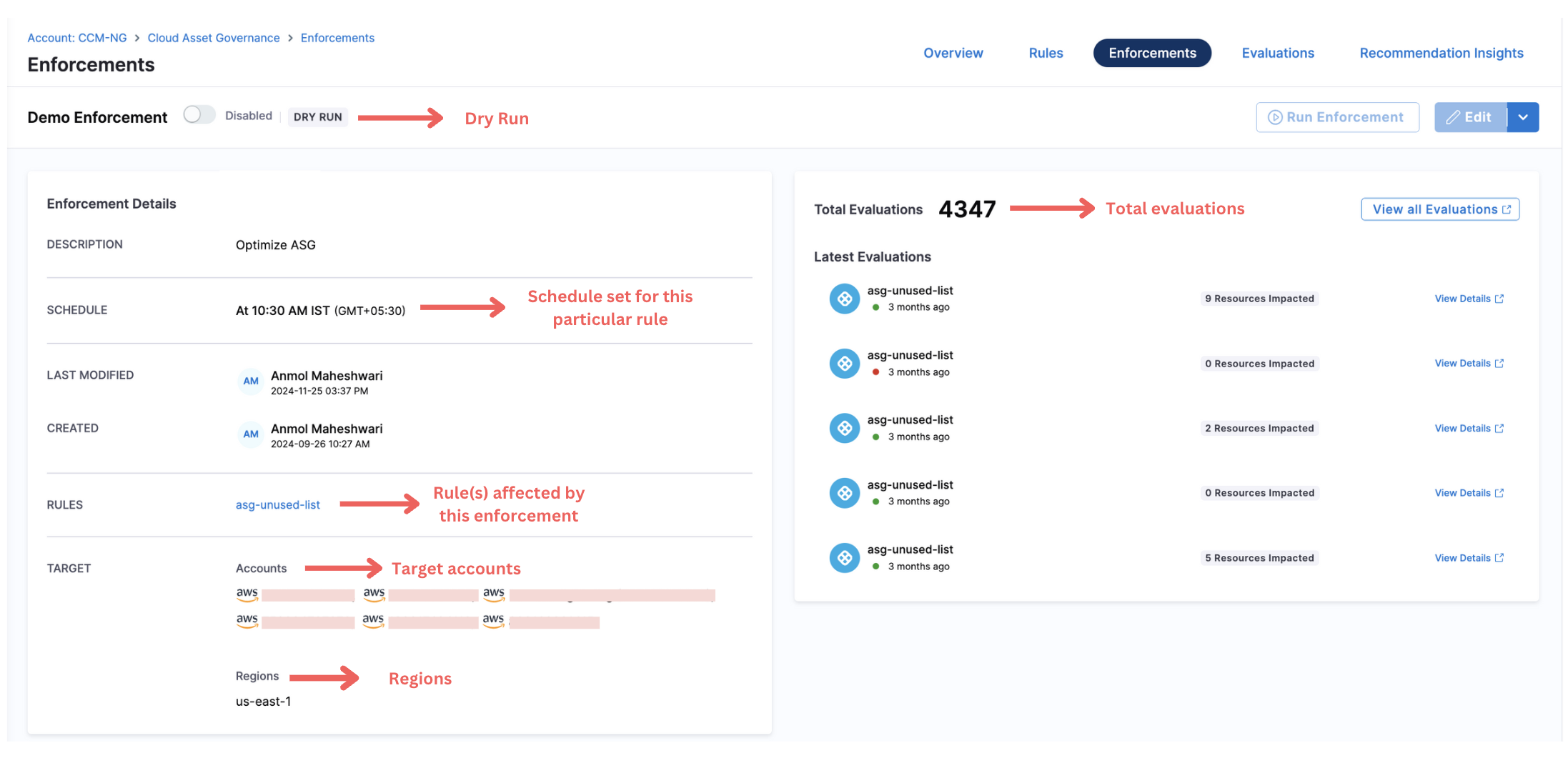
Create a new Enforcement
To create an Enforcement, perform the following steps:
-
In your Harness application, go to Cloud Costs.
-
Select Asset Governance.
-
Select Enforcements.
-
Select + New Enforcement.
-
Enter a name for the Enforcement.
-
Optionally, enter a description of the Enforcement.
-
Select the cloud provider.
-
Select the Rules or Rule Sets that you want to enforce. You can use the Search box if you have multiple rules and are looking to enforce a particular rule or rule set.
-
Select Continue.
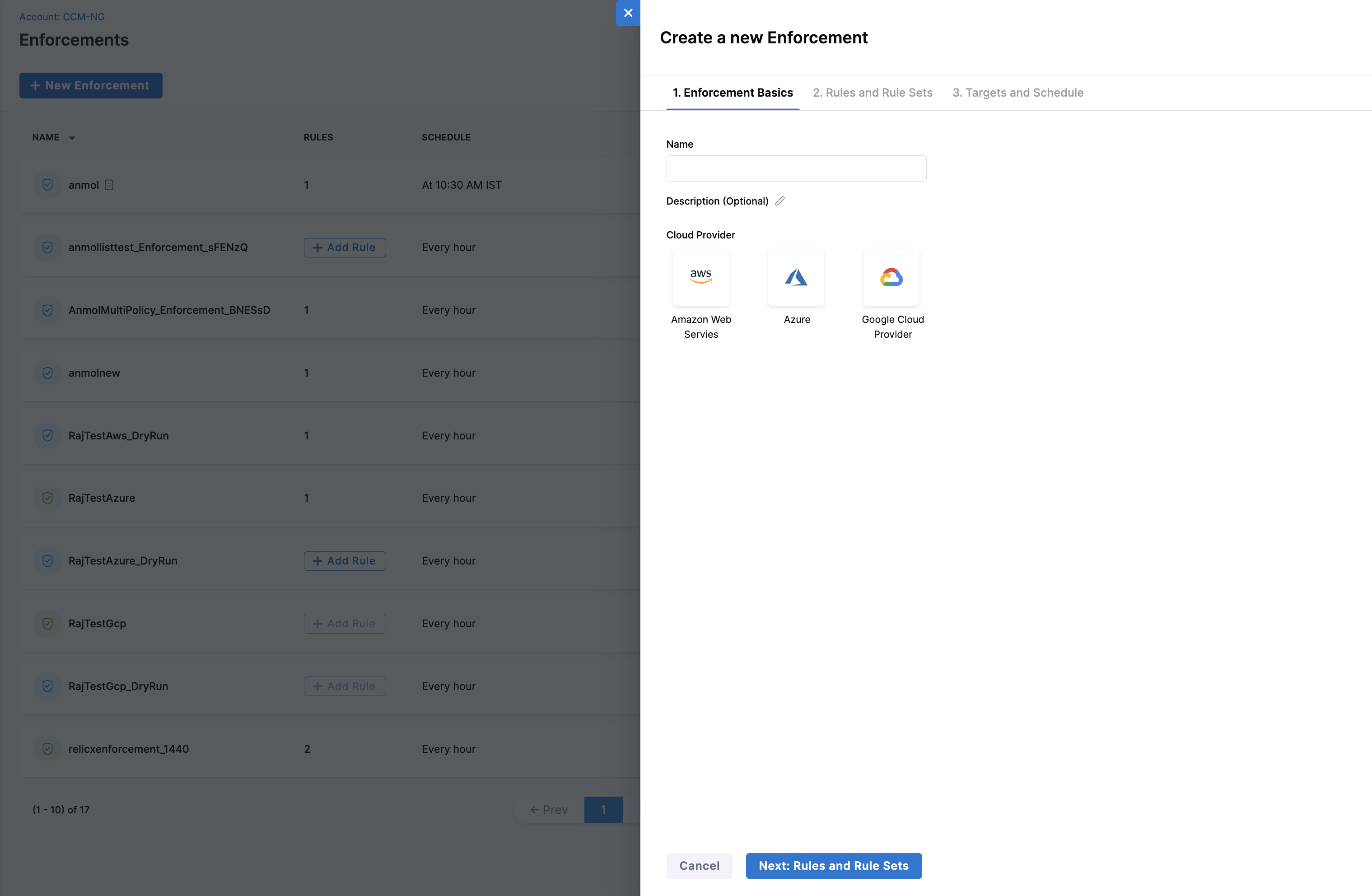
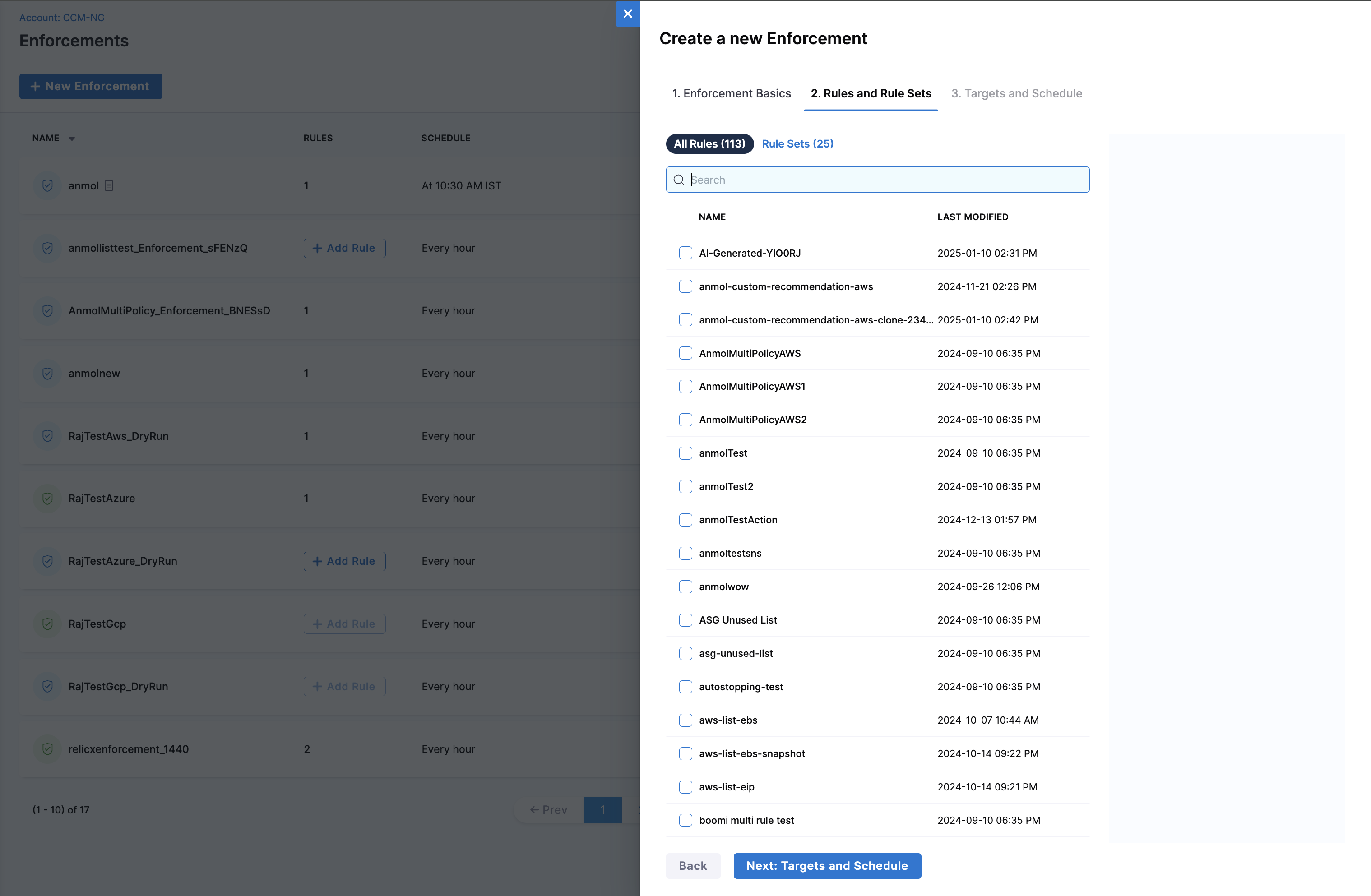
-
Select the target accounts and target regions. You could select multiple accounts and regions.
-
Set the frequency from Hourly, Daily, or Weekly options. In case you select Daily or Weekly, specify the day, time, and time zone to run the rule on schedule.
-
Toggle the Dry Run mode if you do not want to take action immediately.
-
Select Finish.
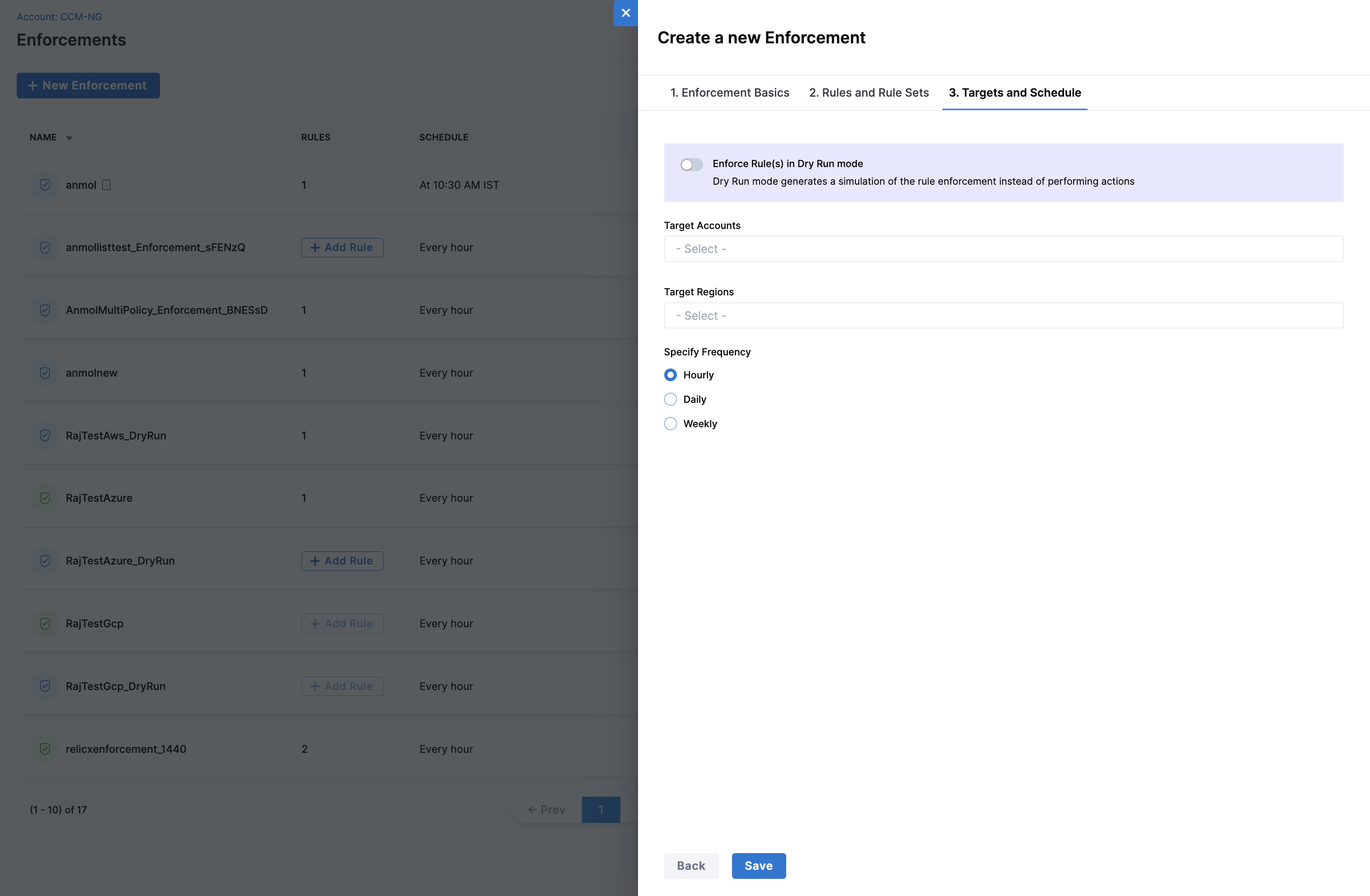
After setting up the schedule, you can view the Enforcement on the Enforcements page.

Furthermore, you can disable the Enforcement at any time using the toggle button in the Status column. If you want to turn off the dry-run mode, select Edit from the vertical ellipsis menu (⋮) then go to "Target And Schedule", use slider to turn off "Enforce Rule(s) in Dry Run mode" and click on Finish.
Update an Enforcement
You can view any Enforcements on Rule Enforcements page. Click on the enforcement to view details such as the rules, target accounts, and regions included in the enforcement. For updating, you can use the "Edit" button from the vertical ellipsis menu (⋮) to update the enforcements as per your convenience.
Delete an Enforcement
To delete an enforcement, simply click on “Delete” from the vertical ellipsis menu (⋮).

We now have Terraform support for managing Governance Enforcements. Please see here for more details.
Evaluations
Evaluations include all the data about enforcements run (both RUN ONCE from rule editor and from Enforcement). The Evaluations window also shows you the total cost impact with each Enforcement i.e. the costs or spendings associated with each Evaluation along with the last time that Rule/Rule set was enforced. With Evaluations, you can view and audit all the Enforcements that ran in the past.
Harness CCM also supports multiple statuses for evaluations. Currently CCM supports three statuses for an evaluation:
- Success: If the evaluation is completed without any errors, the status of the evaluation is shown as "Successful".
- Failure: If the evaluation is not completed and has errors, the status of the evaluation is shown as "Failure".
- Partial Success: If the evaluation is successful without any Harness errors but Cloud Custodian has additional logs and/or in case of multi-policy evaluations, if the evaluation was successful only for a subset of resources, the status is shown as "Partial Success".
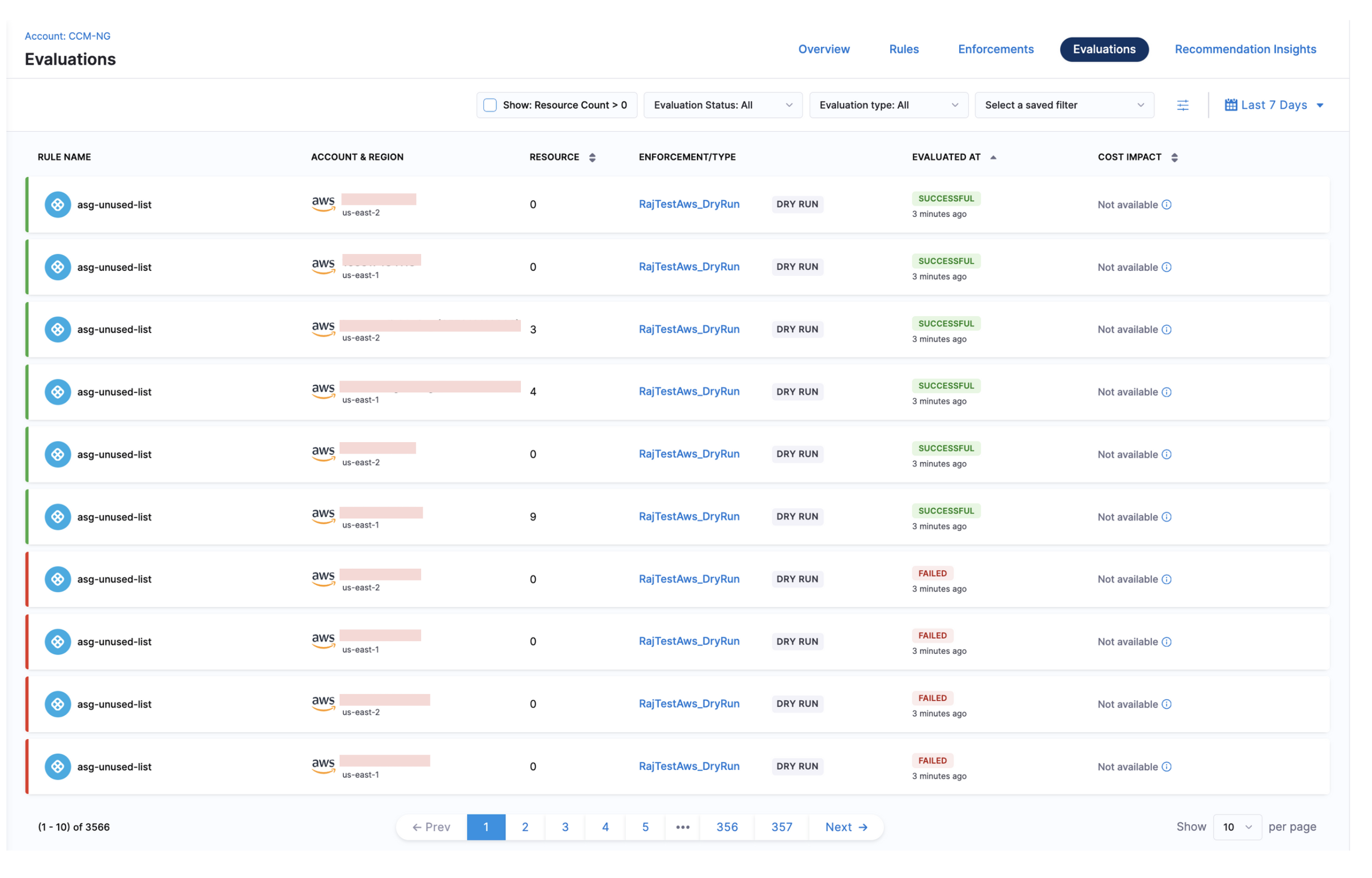
View Evaluations
- In your Harness application, go to Cloud Costs.
- Select Asset Governance.
- Select Evaluations.
- You can see all the Evaluations of Rules listed on the window.
- Select the rule for which you want to view the Evaluation details. The target account, region, identified resources and evaluation logs are displayed.
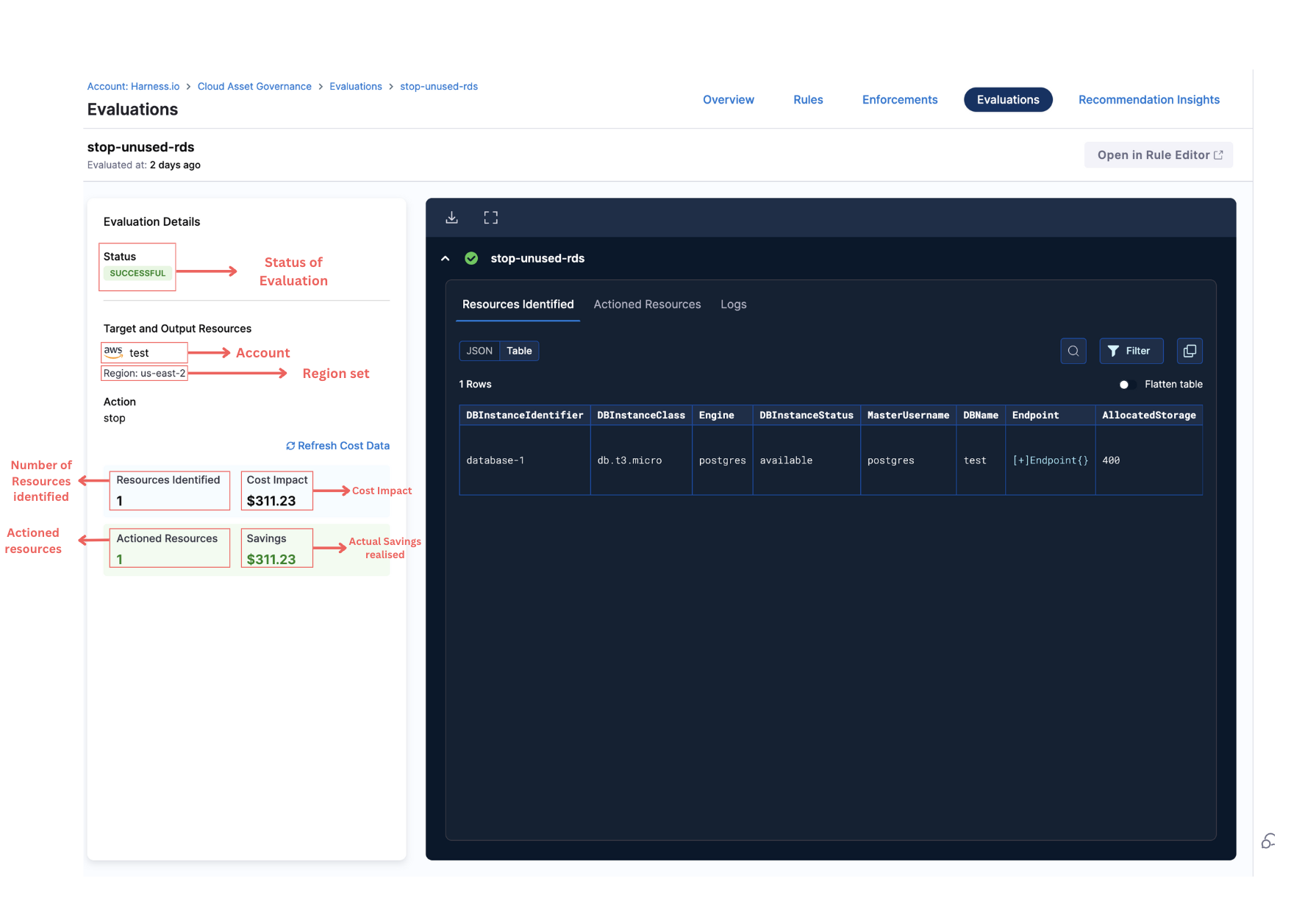
In the output window, users can see the resources identified in form of a Table or JSON. The table view supports all the filters and flattening of the table is supported as well. That essentially means, nested propoerties are flattened. By default, nested objects and arrays are collapsed and can be expanded upto two levels. Further nested properties are shown as formatted JSON.
Filters in Evaluations List Page
You can create filters to view selected rules:
-
Select the filter icon.
-
Enter a name.
-
Select who can edit and view the filter.
-
Select one or more of the following criteria to filter the results:
- Rules
- Rule Sets
- Enforcements
- Minimum Cost Impact ($)
- Cloud Provider
- AWS Filters
- AWS Account
- Target Regions
-
Select Apply.
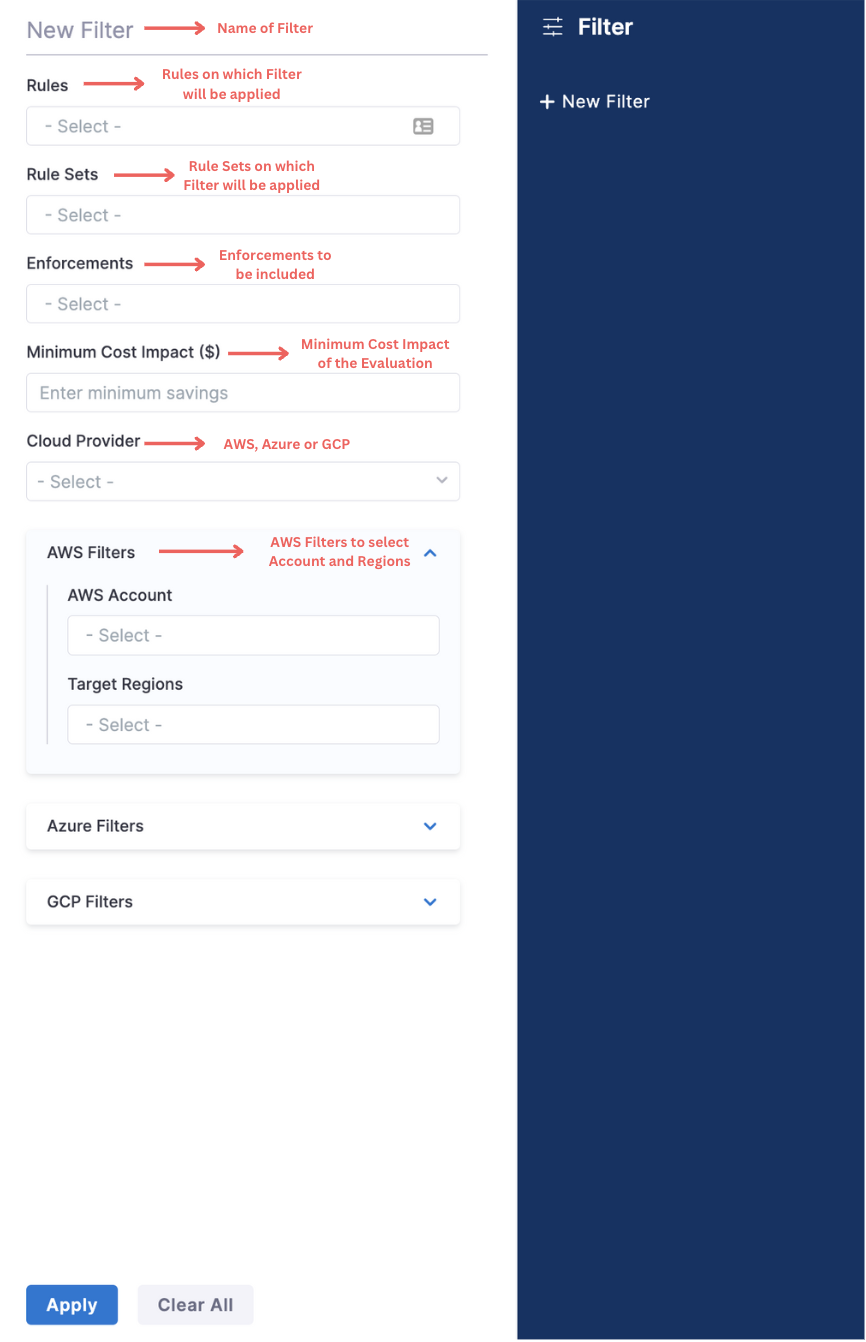
Number of evaluations for which we can compute cost impact is 1,50,000/ Day.
Bulk Export Evaluations
Use Bulk Export to download up to 100 evaluation results (AWS, GCP, or Azure) in a single ZIP file. Export is available when all selected evaluations are in a terminal state (Succeeded or Failed).
How to export
- Click Export.
- Choose the files to include:
metadata.json: summary of each evaluationresources.json: resources identifiedcustodian-run.log: execution logactioned-resources.json: resources acted on
- Click Generate Report.
The ZIP file is organised by evaluation ID (or by policy sub-folders for multi-policy runs) so you can quickly locate results. You can also export from the Test Terminal when evaluating multiple targets.

Testing Terminal
In the rule editor, a test terminal is present for users to see the output in the terminal itself upon evaluating a Rule. This is done to ensure that users can run the rules and try accordingly to check how the output would look on the selected account and region. There are two options: first, to select the target account and second, to select the regions. After providing the relevant inputs, the users can select either to dry run the rule first, run it once or enforce the rule.
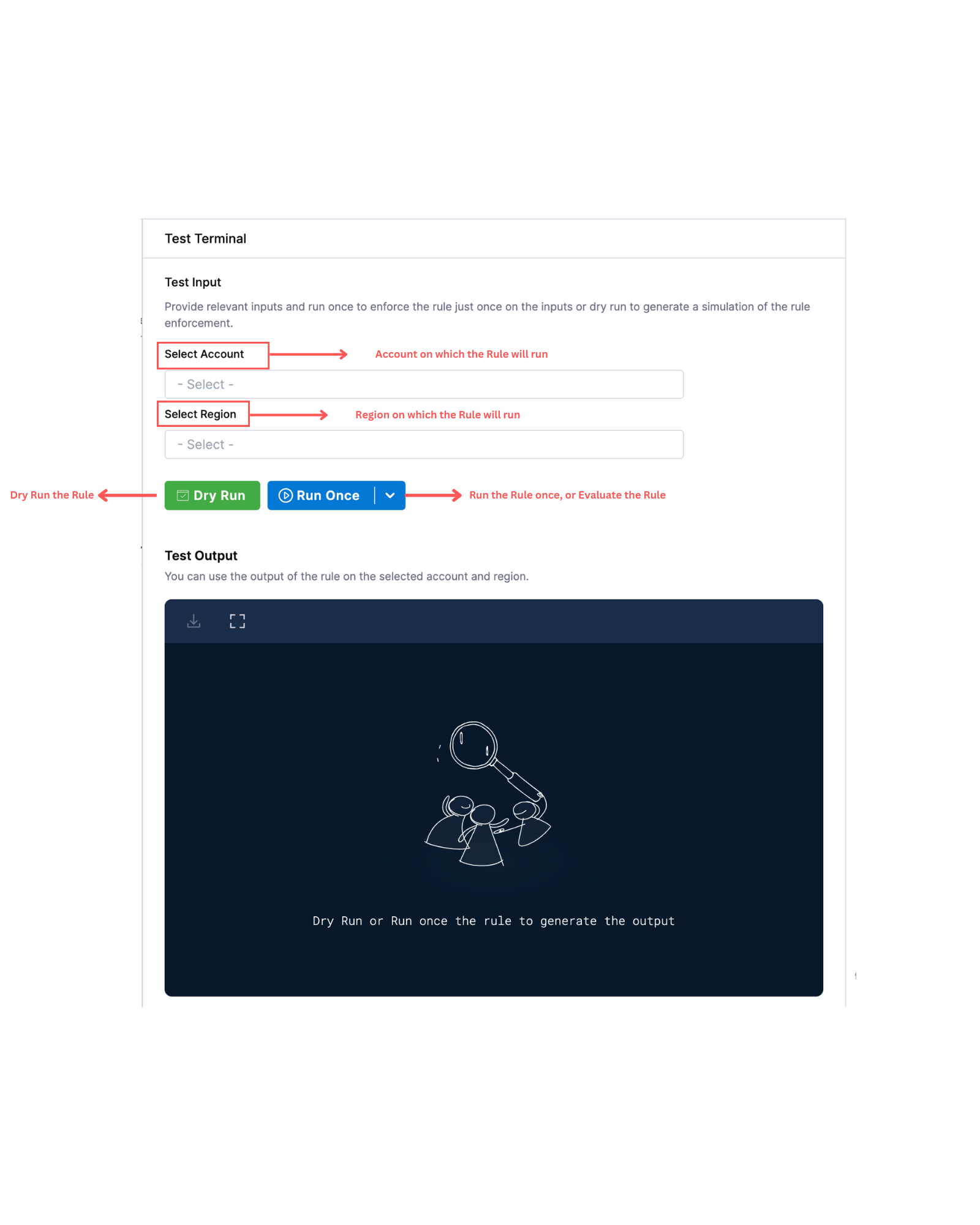
After this, the resources identified are shown on the output terminal in JSON format. With this output, users can perform different actions like searching, downloading, filtering, sorting and picking.
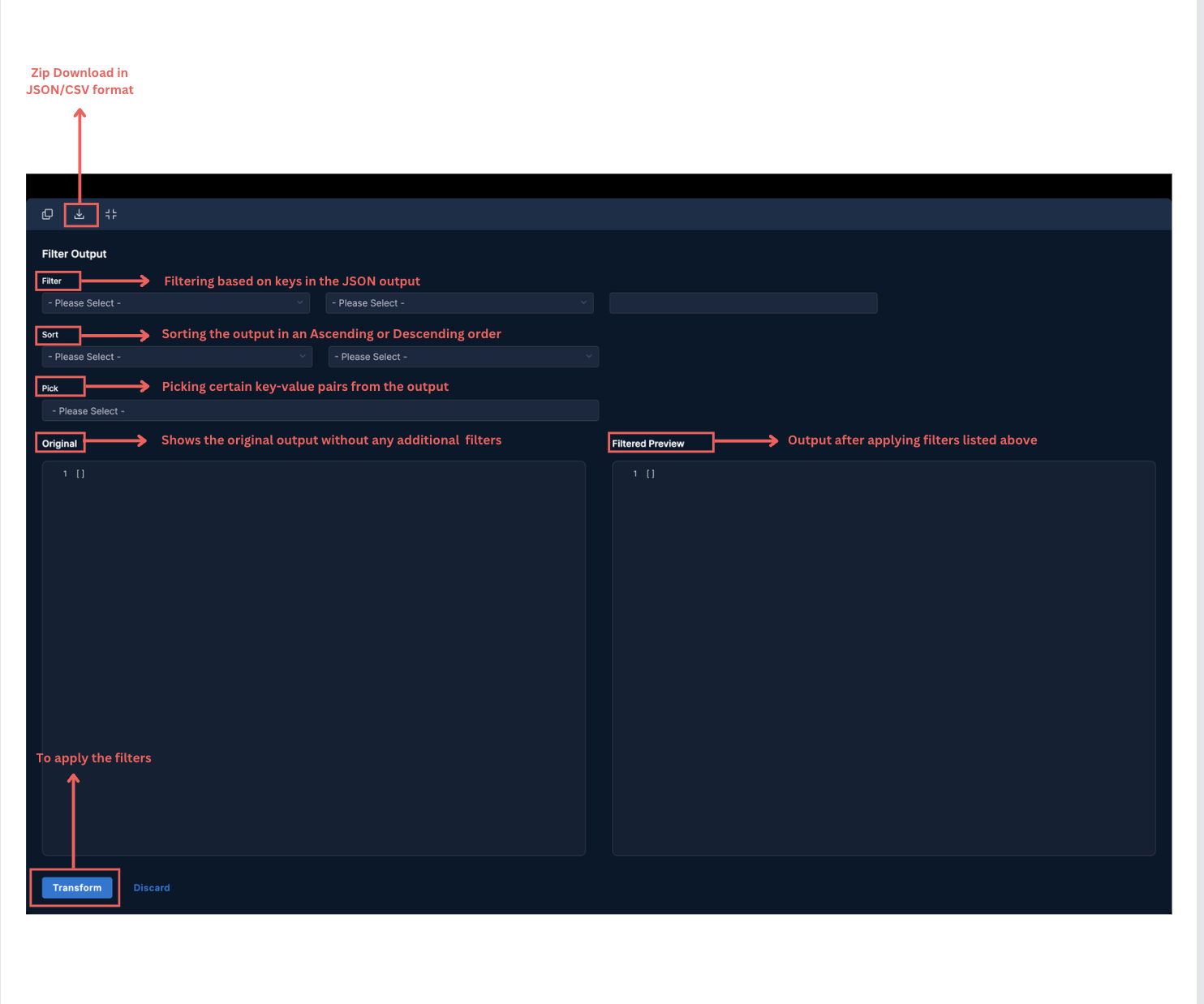
Searching in Output Terminal
After the output is rendered, users can search for any keywords in the output terminal. This streamlines troubleshooting and debugging processes and helps to efficiently locate required information amidst large volumes of output data.
Zip Downloads
The JSON output can be downloaded in either JSON format or a CSV format(original or flatted) into a single zip archive.
JSON Filtering
The output can be filtered based on the keys present in the JSON output. Currently, filtering on the basis of ==, !=, <, <=, >, >= is supported in terms of numeric key values and if the key's value is a string, string matching using LIKE is supported. This feature enables users to extract specific fields, filter out irrelevant data, and perform relevant queries on JSON datasets.
Sorting
The output can be sorted based on the keys present in the JSON output in either an ASCENDING or DESCENDING manner.
Pick
If output needs to be streamlined and only a few keys-value pairs are required, 'Pick' functionality can be used. Using this, users can pick only the required keys and see the data associated with them in the output.
If multiple Regions and/or multiple Accounts are selected, the Output Terminal will render the links to the Evaluations page for all the individual evaluations per Subscription-Region pair. From that page, upon clicking on individual evaluations, detailed output and logs can be seen.